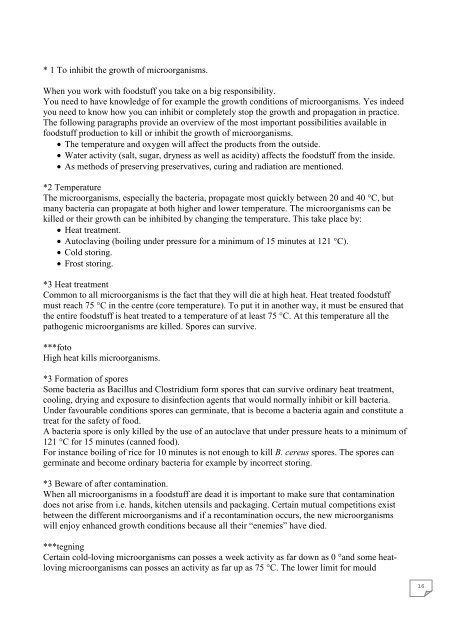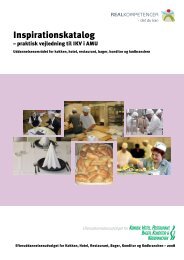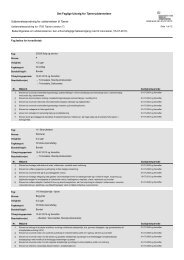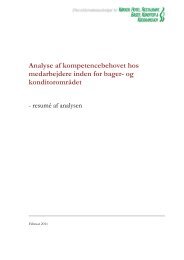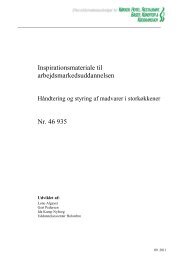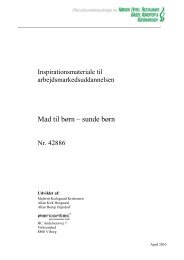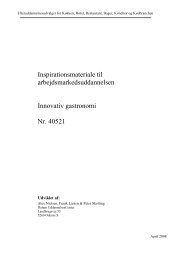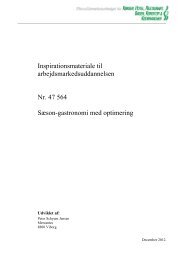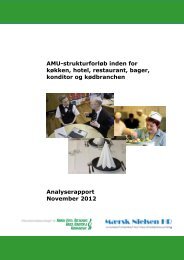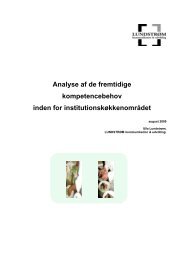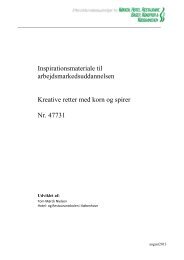General food hygiene - the certificate training
General food hygiene - the certificate training
General food hygiene - the certificate training
Create successful ePaper yourself
Turn your PDF publications into a flip-book with our unique Google optimized e-Paper software.
* 1 To inhibit <strong>the</strong> growth of microorganisms.<br />
When you work with <strong>food</strong>stuff you take on a big responsibility.<br />
You need to have knowledge of for example <strong>the</strong> growth conditions of microorganisms. Yes indeed<br />
you need to know how you can inhibit or completely stop <strong>the</strong> growth and propagation in practice.<br />
The following paragraphs provide an overview of <strong>the</strong> most important possibilities available in<br />
<strong>food</strong>stuff production to kill or inhibit <strong>the</strong> growth of microorganisms.<br />
• The temperature and oxygen will affect <strong>the</strong> products from <strong>the</strong> outside.<br />
• Water activity (salt, sugar, dryness as well as acidity) affects <strong>the</strong> <strong>food</strong>stuff from <strong>the</strong> inside.<br />
• As methods of preserving preservatives, curing and radiation are mentioned.<br />
*2 Temperature<br />
The microorganisms, especially <strong>the</strong> bacteria, propagate most quickly between 20 and 40 °C, but<br />
many bacteria can propagate at both higher and lower temperature. The microorganisms can be<br />
killed or <strong>the</strong>ir growth can be inhibited by changing <strong>the</strong> temperature. This take place by:<br />
• Heat treatment.<br />
• Autoclaving (boiling under pressure for a minimum of 15 minutes at 121 °C).<br />
• Cold storing.<br />
• Frost storing.<br />
*3 Heat treatment<br />
Common to all microorganisms is <strong>the</strong> fact that <strong>the</strong>y will die at high heat. Heat treated <strong>food</strong>stuff<br />
must reach 75 °C in <strong>the</strong> centre (core temperature). To put it in ano<strong>the</strong>r way, it must be ensured that<br />
<strong>the</strong> entire <strong>food</strong>stuff is heat treated to a temperature of at least 75 °C. At this temperature all <strong>the</strong><br />
pathogenic microorganisms are killed. Spores can survive.<br />
***foto<br />
High heat kills microorganisms.<br />
*3 Formation of spores<br />
Some bacteria as Bacillus and Clostridium form spores that can survive ordinary heat treatment,<br />
cooling, drying and exposure to disinfection agents that would normally inhibit or kill bacteria.<br />
Under favourable conditions spores can germinate, that is become a bacteria again and constitute a<br />
treat for <strong>the</strong> safety of <strong>food</strong>.<br />
A bacteria spore is only killed by <strong>the</strong> use of an autoclave that under pressure heats to a minimum of<br />
121 °C for 15 minutes (canned <strong>food</strong>).<br />
For instance boiling of rice for 10 minutes is not enough to kill B. cereus spores. The spores can<br />
germinate and become ordinary bacteria for example by incorrect storing.<br />
*3 Beware of after contamination.<br />
When all microorganisms in a <strong>food</strong>stuff are dead it is important to make sure that contamination<br />
does not arise from i.e. hands, kitchen utensils and packaging. Certain mutual competitions exist<br />
between <strong>the</strong> different microorganisms and if a recontamination occurs, <strong>the</strong> new microorganisms<br />
will enjoy enhanced growth conditions because all <strong>the</strong>ir “enemies” have died.<br />
***tegning<br />
Certain cold-loving microorganisms can posses a week activity as far down as 0 °and some heatloving<br />
microorganisms can posses an activity as far up as 75 °C. The lower limit for mould<br />
16


